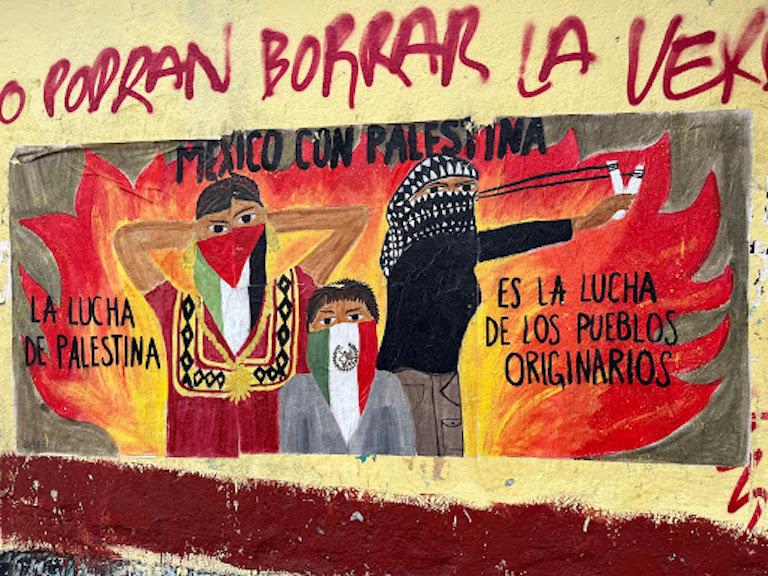Spanish translation:
Mexico (is) with Palestine
The struggle of Palestine is the struggle of indigenous peoples
Note: This mural expressing solidarity with Palestine that has been painted, repeatedly erased by authorities, and repainted
Source:
https://trail.pugetsound.edu/?p=18567
Photo Credit: Mercer Stauch // The Trail
El Arte de la Resistencia: A Portrait of Visual Protest Culture in Oaxaca, MX
By Mercer Stauch
Oaxaca, Mexico is the destination for hundreds of thousands of tourists every year who come to steep themselves in a city that advertises itself as a well-preserved cultural treasure – meandering the historic El Centro neighborhood gives one the impression they’re passing through colonial-era New Spain. Ruins of pre-hispanic cities (Yagul, Monte Albán) aren’t far either, and the number of museums and historical markers lends itself to the narrative that Oaxaca is indeed frozen in time.
For native Oaxacans, this couldn’t be further from the truth. The less advertised dimension of this society is the firm and courageous public sense of progress, justice, and protest. During my three months studying here, I’ve seen upwards of 20 protests. The Oaxacan police are well practiced at blocking traffic for the duration of these marches, and non-participants treat them as a normalcy. Public art backs up the public protest; outward-facing walls of most buildings (truly, a blank surface is an unusual sight) decry a government failure, illuminate a crime met with impunity, or mourn a wrongful death. This graffiti forces the viewer to confront the region’s imperfections, and demonstrate a forward-looking perspective that chafes with the image typically sold to the city’s tourist audience.
We can look to history to explain this phenomena. In 2006, protesters from the Oaxacan section of the Mexican national teacher’s union set up an encampment in el Zócalo, the historic center of the city, demanding expanded school funding, teacher pay, and scholarship opportunities for their students. They were met with brutal force from police that sought to remove them, leading to five months of clashes between state and federal police and students, teachers, indigenous groups, women’s rights activists, and thousands of independent Oaxacans that joined to oppose an oppressive government. My host parents, one of whom was a teacher providing food to the movement, described months of fear, but also of incredible resilience and comradery. My host father noted how quickly everyone realized that Oaxaca could function without police or government; in his words, the city could run on the goodwill of the public, even if just for a while.
Eventually, the protests were quelled by over 5,000 national police, and teachers went back to work, their demands largely unanswered. What was never quelled was the distinct role graffiti played in those months. On the contrary, the language of street protest art is more alive than ever. The Israeli occupation of Palestine; the femicide rate in Oaxaca and across Mexico; the 43 kidnapped Ayotzinapa College students who have yet to be found; these and more are issues that street artists forbid be forgotten.
Most commonly these messages are rendered as spray-painted phrases or as grabados, paper images produced by a wood-carved stencil and black paint. The latter medium surged in popularity during the 2006 conflict because of its reproductive efficiency and because the process doesn’t require electricity, access to which could be throttled by the government. The imagery itself takes on countless evocative forms. Often you can find Marxist or leftist iconography alongside phrases that criticize servidumbre, el estado, or el ejército. Another common theme juxtaposes innocence with violence; the Virgin of Guadalupe wearing a tear gas mask, an elderly woman firing a shotgun, or a man in a hazmat suit cautiously approaching a single stalk of corn. They send a clear message: the struggle for basic human rights excludes no one.
At times, a walk through Oaxaca can be overwhelming. For better or for worse, the artistic community of Oaxaca has taken it upon itself to combat ambivalence and complacency on as many social justice fronts as the city’s outward-facing walls will allow. I’m fascinated by all ways in which media can make people care; street art is never one I had put much thought into before, but it has an undeniable power here. Its most important impact, in my mind, is on the millions of visitors, myself among them, that arrive in Oaxaca not expecting to be moved by its tangible passion for social justice. And I’m certain that I’m not the only one to leave carrying the urge to play my part in the pursuit of a more equitable world.
Muchísimas gracias a Sofía Isabel Navarro por su colaboración en el proyecto de investigación que facilitó unas partes de este artículo, y al Prof. Jorge Hernández por compartir su conocimiento y contexto.
Source:
https://trail.pugetsound.edu/?p=18567
__________________________________________________

